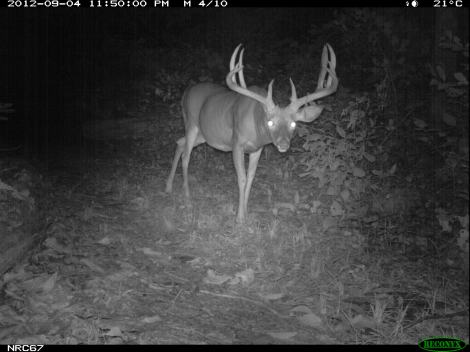White-tailed deer (Odocoileus virginianus) are one of the most commonly seen wildlife species around the east (click for range map), and this abundance brings many wildlife viewing and hunting opportunities as well as the negatives of increased vehicle collisions and plundered gardens and rose beds. Because white-tailed deer are so common they also give us the opportunity to see behaviors that we do not get to see for other animals.
A spectacular set of deer behaviors occurs during the rut, or the breeding season of deer in the late fall (or winter depending on location). All of the rut behaviors are driven by the fact that female deer, or does, will only be able to conceive for 2 to 3 days during their estrous cycle. If a male, or buck, wants to pass on his genes, he needs to be in the right place during those 2 days.
Bucks will start sparring in the weeks leading up to main part of the rut. These early sparring sessions are mainly to establish hierarchy for later in the rut. As the rut advances dominant bucks will start hanging around family based female groups, and more dominant the buck the larger the area and the more groups he will try to cover. He will drive off all other bucks, and often times does will cluster around larger bucks for defense from harassment from younger males.
As the dominant buck makes the rounds between female groups he must assess whether to stay and try and breed or move on. He will smell her urine and exhibits the flehman expression, where he curls his upper lip back and raises his head. This opens the pathway to the vomeronasal organ in the roof of his mouth that analyzes the hormones in the doe’s urine and assesses here mating status. If the doe is ready or very close to ready to mate the buck will stick around and chase the doe relentlessly until she is ready to mate.
Once a buck mates with a doe he will immediately move on and search for the next doe approaching estrus. Experience matters in this whole affair, and often a relatively large buck early in his dominant stage of life will tend a group of does only to have a large older male swoop in and drive him off much closer to the time that the does are ready to breed.
For more information about white-tailed deer:
Sources
Elbroch, Mark and Kurt Rinehart. Behavior of North American Mammals. New York: Houghton Mifflin, 2011. 374 pgs.
Smith, W. P. 1991. Odocoileus virginianus. Mammalian Species 388:1-13.



Great information–thank you! Happy to have stumbled upon it today as I was writing my own blog post about deer–it came up as a Related Article suggestion, so I linked to it here: http://www.joyfullygreen.com/2013/06/our-love-hate-relationship-with-deer.html.
Looking forward to reading more from you.
Best,
Joy